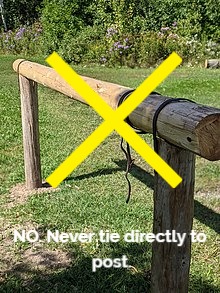Prevention: Pulling Back
- Heather U

- Mar 6, 2024
- 4 min read
In my work, I often see horses that have sustained trauma in the poll region, face, nose, and neck as a result of pulling back while tied. It is all too common to avoid as a topic, and highly preventable so I'd like to use this post for the purposes of helping horse owners so that they may prevent this from happening altogether. The injuries sustained by horses that pull back are not only painful for the animal, but also time consuming to rehabilitate. In some cases, the damage is permanent.
What is the Poll? This is not a joint but rather an area that goes along the horse's head just between/behind the ears where the halter will rest. When the halter tightens from the horse pulling back, a great amount of tension is placed on the poll region, leaving bruising, muscle tension, and even causing certain joints to become out of alignment (often resulting in calling the equine chiropractor).

Perhaps the obvious answer for poll related injuries caused from pulling back is training, and while I do wholeheartedly agree that our horses should have solid foundational training so that they know how to stand tied quietly and even ground tie, I want to focus on how we can keep our horses safe regardless of training background. There are many different training methods out there and lots of great equine training content available online with professional trainers who demonstrate ways to teach the horse who to tie and ground tie, so I encourage anyone with a horse that doesn't like to tie or doesn't yet know how to ground tie to investigate those resources further.
This particular article will focus more on what we as owners can do in any situation with horses that are trained, still learning, or with horses we don't know well enough to understand their ability to tie such as friend's horses or new horses.
HALTERS. Many horses are wearing halters that do not properly fit or that are not fastened correctly. This is a COMMON occurrence and easily remedied by ensuring that our halters whether nylon, rope, or leather, fit the horse's head, and are buckled or tied correctly. A halter too loose or too tight poses a great amount of risk for injury to the horse's head and does not serve its purpose in allowing us to use the halter to give the correct signals to the horse.
2. LEADS. Invest in good quality lead ropes. Be rid of frayed ropes and never use a wet lead rope to tie a horse as wet material often gets stuck quite easily if the horse should move around. I personally recommend long, 12-15 ft leads for a myriad of benefits including added safety reasons, but if using a standard lead rope, ensure the material is slick enough for safe and quick untying and yet sturdy enough to safely hold your horse.
3. SAFETY TOOLS. I highly recommend using a "safety ring" in some form or fashion for all horses of all levels while tying and I NEVER tie a horse directly to any object. (For example, I don't tie to a hitching post unless there are safety rings, and I don't tie directly to the horse trailer or to a stall). This is because of the potential damage to be done should the horse pull back. Even the best of horses have bad days and can have a "moment", or "spook" causing unnecessary injury. Instead, tie the horse to a quick release safety ring whether it's plastic, metal or homemade with twine. The point is that the horse should be able to break free easily should he pull back.
4. OTHER SAFETY MEASURES. Never tie your horses to a tree. If the branch was to break, it can swing down into your horse causing serious injury or it can land on the ground near him and entangle him if he should spook.
Avoid tying horses to anything that is not specifically created for hitching horses; only hitching rails, horse trailer ties, patience poles, etc should be used as they were specifically designed for the horse's weight.
Never use a hitching post that isn't at least five feat tall. I personally prefer vertical posts over horizontal posts. Why? If a horse were to panic and go forward, he can hang himself over the hitching post (if too short), or break his sternum. I have personally witnessed this happening in the past, and the horses had to be euthanized as a result.
5. USE A QUICK RELEASE method. Always tie your horses using a "quick release knot" so that if needed, you can simply tug on the rope to release him. I cannot stress this enough. Alternatively, teach him to ground tie, so that you can simply put the rope through the "safety ring" without tying any knot at all. (See video demonstration below on how to tie a quick release knot).
I hope you've found these tips for preventing common equine injuries useful and continue to wish you the best in your horsemanship journey.







Comments